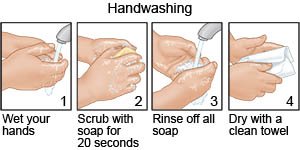Valley Fever
Medically reviewed by Drugs.com. Last updated on Aug 4, 2025.
What is valley fever?
Valley fever, or coccidioidomycosis, is an infection caused by a fungus. You can get the infection if you breathe in the fungus germs. The germs are found in soil and dust in parts of the United States, Mexico, Central and South America. In the United States, most cases of valley fever occur in California, Texas, Arizona, and New Mexico.
What are the signs and symptoms of valley fever?
You may develop the following flu-like symptoms 1 to 4 weeks after you breathe in the fungus:
- Cough or trouble breathing
- Fever, chills, or night sweats
- Chest, joint, or muscle pain
- Tiredness or headache
- A rash
- Tender, swollen, red lumps on your legs
- Loss of appetite or weight loss
How is valley fever diagnosed?
Your healthcare provider will ask about your symptoms and examine you. Tell him or her if you have traveled recently or if you work outside. You may need any of the following tests:
- Blood tests may show the fungus that causes valley fever.
- A sample from your throat or the inside of your nose may be needed. You may need to cough mucus into a cup. A cotton swab may be used to get a sample from an open rash or wound. These are tested for the fungus that causes valley fever.
- An x-ray may show signs of infection, such as swelling and fluid around your lungs.
- A lung biopsy may be done to test for signs of a fungal infection. Lung tissue is removed and sent to a lab for tests.
How is valley fever treated?
Your symptoms usually go away on their own. It may take up to 2 months for your symptoms go away. You may need any of the following:
- NSAIDs , such as ibuprofen, help decrease swelling, pain, and fever. This medicine is available with or without a doctor's order. NSAIDs can cause stomach bleeding or kidney problems in certain people. If you take blood thinner medicine, always ask your healthcare provider if NSAIDs are safe for you. Always read the medicine label and follow directions.
- Cough medicine may help soothe your throat and decrease your urge to cough.
Treatment options
The following list of medications are related to or used in the treatment of this condition.
How can I manage my symptoms?
- Rest as directed. Slowly start to do more each day.
- Drink liquids as directed to help prevent dehydration. Ask how much liquid to drink each day and which liquids are best for you.
- Use a cool mist humidifier to increase air moisture in your home. This may make it easier for you to breathe and help decrease your cough.
- Record the color and amount of sputum you cough up. Bring this record to your follow-up visits.
How can I prevent valley fever?
- Cover your nose and mouth. Use masks or cloths to cover your nose and mouth while working in the soil.
- Wash your hands after you handle plants and soil. Use soap and water every time. Rub your soapy hands together, lacing your fingers. Wash the front and back of your hands, and in between your fingers. Use the fingers of one hand to scrub under the fingernails of the other hand. Wash for at least 20 seconds. Rinse with warm, running water for several seconds. Then dry your hands with a clean towel or paper towel.

Call your local emergency number (911 in the US) if:
- You have severe chest pain.
- You have trouble breathing or your breathing seems faster and more shallow than usual.
- You are confused or sleepy.
When should I seek immediate care?
- Your lips or nails turn blue.
- You cough up blood.
- You have a headache, a stiff neck, and a fever.
When should I call my doctor?
- Your symptoms do not improve within 2 months.
- You have night sweats for longer than 3 weeks.
- You lose more than 10% of your weight.
- You cannot work because of your symptoms.
- Your lymph nodes are swollen.
- You have questions or concerns about your condition or care.
Care Agreement
You have the right to help plan your care. Learn about your health condition and how it may be treated. Discuss treatment options with your healthcare providers to decide what care you want to receive. You always have the right to refuse treatment. The above information is an educational aid only. It is not intended as medical advice for individual conditions or treatments. Talk to your doctor, nurse or pharmacist before following any medical regimen to see if it is safe and effective for you.© Copyright Merative 2025 Information is for End User's use only and may not be sold, redistributed or otherwise used for commercial purposes.
Further information
Always consult your healthcare provider to ensure the information displayed on this page applies to your personal circumstances.
